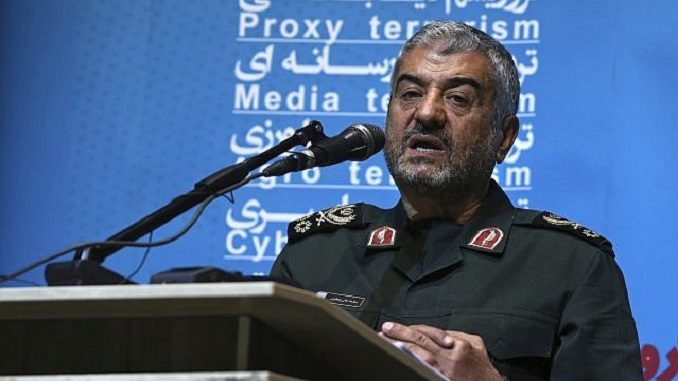
Commander of the Islamic Revolution Guards Corps (IRGC) Major General Mohammad Ali Jafari downplayed enemies’ military threats against Iran, stressing that the new sedition which showed itself in the form of recent unrests and riots in the past few days has ended, Fars News reports. Jafari said that only 15,000 people had turned out at the height of the rallies and that the main “troublemakers” have been arrested.
“The enemies know that they cannot threaten the Islamic Republic of Iran in the defense field and they have spent all their capitals after the sacred defense (Iraqi-imposed war against Iran 1980-1988) to implement their cultural, economic and security threats against the Islamic Iran and they will certainly fail in these arenas too, with God’s help,” General Jafari said on Wednesday.
He referred to the recent unrests and riots during the economic protests in a number of Iranian cities and towns, and said: “Now we can say that it is the day when the (Iranian year of) 1396 (2018) sedition ended.”
Warning that the U.S., the Zionists and the Saudi regime have ordered the ISIL terrorist group to penetrate Iran, he said a number of leading ISIL teams have been tasked with infiltrating the country to conduct sabotage and terrorist acts.
“These leading teams of the criminal group are now fully under control.”
His comments echoed those by Supreme Leader Ayatollah Ali Khamenei on Tuesday, which also blamed unspecified “enemies” and which analysts believed referred to the U.S., Israel and Saudi Arabia. But the general also blamed a “former official” for the protests, in a comment analysts believe referred to ex-President Mahmoud Ahmadinejad, who has been critical of government officials, in particular, Judiciary Chief Sadegh Amoli Larijani, in recent weeks.
He said the terrorists are too weak and do not dare to cross Iran’s borders. General Jafari also said that many of the rioters arrested since Friday were anti-revolutionary forces and members of Mojahedin-e Khalq Organization (MKO, also known as the MEK, PMOI and NCRI) terrorist group.
“In addition to the 5000 forces trained, as announced by Ms. Clinton, to create riot, anarchy, insecurity, and intrigue in Iran, a huge number of anti-revolutionary agents, pro-monarchists, and MKO members were tasked with creating and developing riot and anarchy in Iran. Today, I can pronounce, that the intrigue of 96 is over and defeated,” he noted.
Jafari offered no evidence of how the movement had been defeated beyond the arrests, and his comments appeared to be a warning against more rallies. The protests began last Thursday over Iran’s stagnant economy and the rising cost of living but quickly have developed into a broader outcry against the government.
The numbers turning out for rallies have dwindled in recent days, but the protests continued Tuesday night in at least 10 cities. Authorities have detained at least 450 people, and 21 others have been killed in the unrest. Three members of the Revolutionary Guard Corps were killed during clashes with “anti-revolution agents” along the border in western Piranshahr region, the semiofficial Mehr News Agency reported, citing a statement from Iran’s Intelligence Ministry. The statement did not say whether the fighting was connected to the anti-government protests.
As what was described by the state media as “the revolutionary outburst of Iranian people against lawbreakers” took place in towns and cities, General Mohammad Ali Jafari announced that units of the Guards had been deployed in the three provinces of Isfahan, Lorestan and Hamadan, which had been the main centres of the demonstrations, to put down anti-government unrest after six days of protests that have rattled the clerical leadership and left 21 people dead.
The protests, which began last week over economic hardships suffered by the young and working class, have evolved into a rising against the powers and privileges of a remote elite, especially supreme leader Ayatollah Ali Khamenei. The unrest continued to draw sharply varied responses internationally, with Europeans expressing unease at the delighted reaction by U.S. and Israeli leaders to the display of opposition to Iran’s clerical establishment.
Defying threats from the judiciary of execution if convicted of rioting, protests resumed after nightfall with hundreds hitting the streets of Malayer in Hamadan province. Videos carried by social media showed protesters in the northern town of Nowshahr shouting “death to the dictator.”
The Revolutionary Guards, the sword and shield of Iran’s Shi‘ite theocracy, were instrumental in suppressing an uprising over alleged election fraud in 2009 in which dozens of mainly middle-class protesters were killed. Khamenei condemned that unrest as “sedition.”
Yet, Reuters news agency is reporting fresh protests after nightfall on Wednesday in the city of Malayer in western Hamadan province, with protesters chanting: “People are begging, the supreme leader is acting like God!” Video on social media showed protesters in Nowshahr in the north chanting “death to the dictator”, a phrase that has been used against Ayatollah Khamenei, the agency reported.
Associated Press said other videos had emerged on Wednesday of protesters tearing down images of the ayatollah in Noor Abad, 360km south-west of Tehran, although it was unclear when the footage was shot.
Meanwhile, three members of the security services have been killed in Piranshahr, an area in West Azerbaijan province which borders Iraqi Kurdistan, according to a statement by the Revolutionary Guards. However, the area occasionally sees clashes with Kurdish separatists based in Iraq, and the attack is not thought to be linked to the recent protests.
